I am on vacation in the UK now, traveling about the islands in the Orkney chain off the north coast of Scotland. These islands are remarkable both for their breathtaking natural beauty and wealth of major archaeological sites.
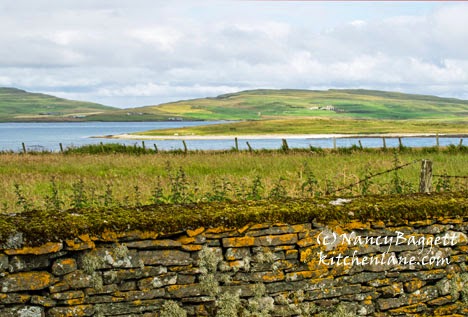 |
| View from Hackness Battery, island of Hoy |
The air and water are clean and clear and landscapes serene and bucolic. Since I am on the road visiting a new island nearly every day, I’m going to keep this post short, and mostly let the images tell the story of our trip.
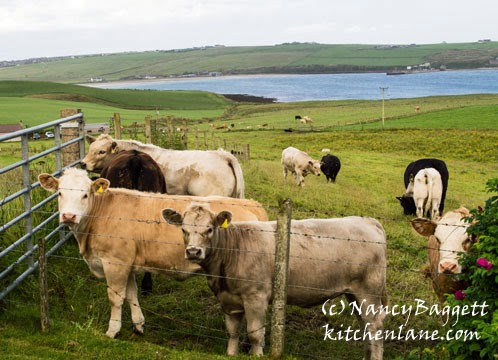 |
| Cattle grazing on the Orkney Mainland island |
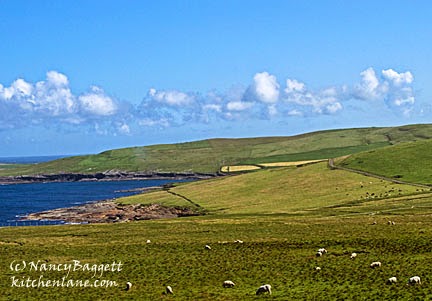 |
| Sheep grazing on the island of Sanday |
As the two photos just above suggest, farming is the major industry; we’ve seen cattle and sheep grazing on all twelve islands we visited. Archaeological evidence indicates that the inhabitants have raised cattle here for more than 5,000 years–their bones have been found in Neolithic settlement sites, including the amazing Skara Brae pictured below; a whole community lived in this stone village dating back to about 3,000 BC!
 |
| Skara Brae Neolithic Village, Mainland, Orkney |
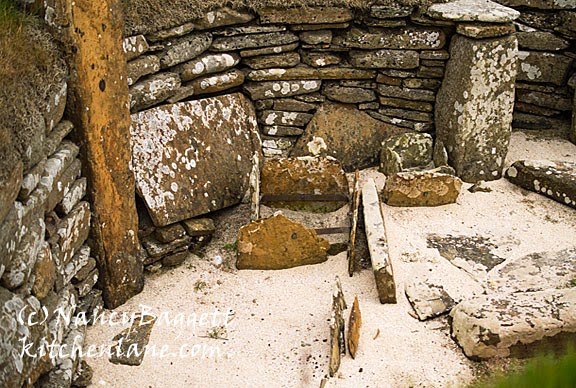 |
||
| Interior of a Skara Brae family “home.”
|
Even more common that Neolithic villages are burial cairns, such as the “stalled” Mid Howe structure pictured above. It is massive compared to most though, with 12 stalls running along a central passage and a tomb that stretches a length of 77 feet.
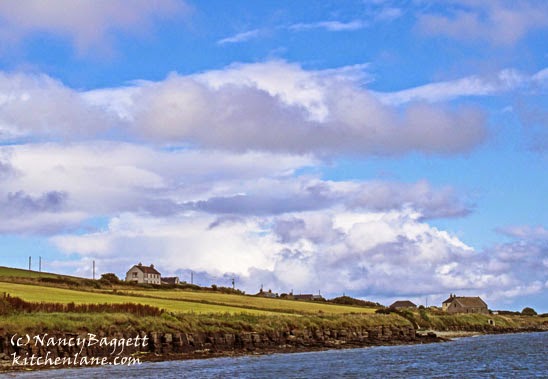 |
| View from Aynhallow Sound of Rousay harbor. |
Many Orkney vistas feature water–from the ample scattering of bright blue lochs inland to harbors and the miles of rocky coastline that meet the north Atlantic and North Sea. Due to the coastal waters, plus salmon farms, most islands are also home to some fishermen.
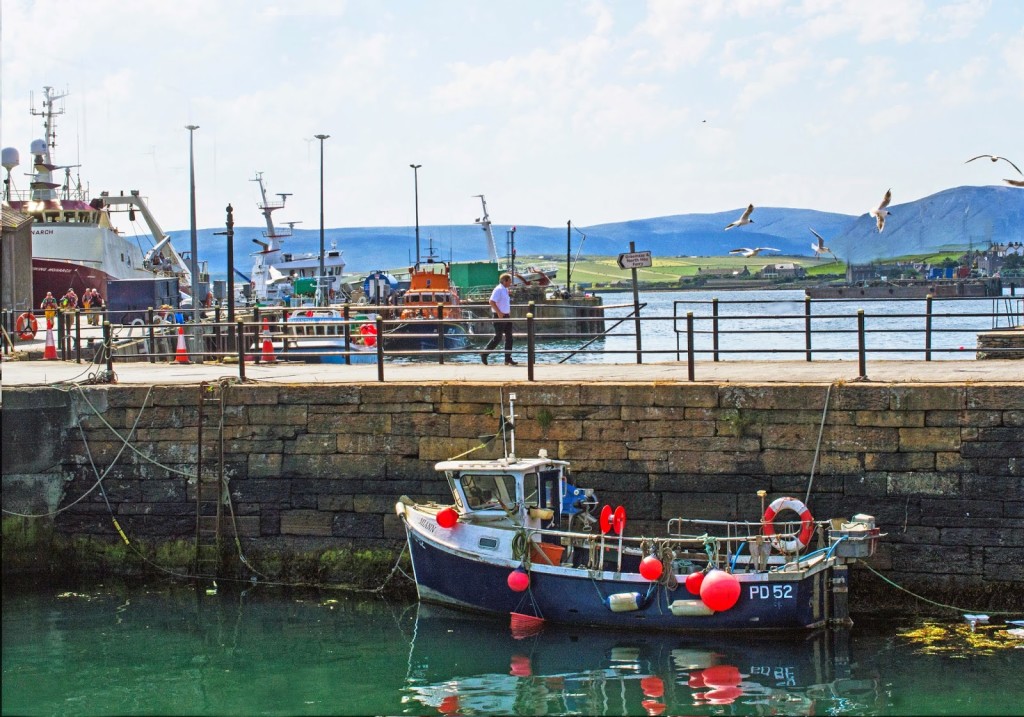 |
| Stromness harbor, Mainland, Orkney |
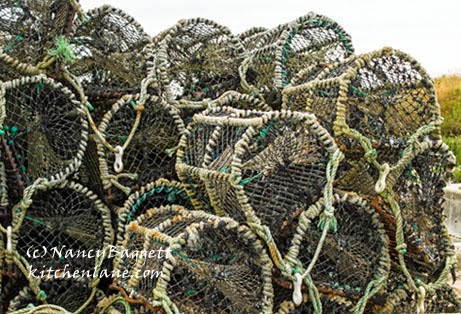 |
| Creel pots, Tingwall Pier, Mainland, Orkney |
Their creels (crab and lobster pots) and weathered wooden fish boxes can been seen stacked up on piers from Pierowall in Rousay, to Tingwall on the Mainland, to Kettletoft on the island of Sanday. We’ve enjoyed pristinely fresh scallops, mussels, prawns, salmon, haddock, and several dishes that featured the crabs below.
 |
| Brown crabs on Pierowall Pier, Westray, Orkney |
Classic Shortbread
I’ve been eating a lot of shortbread on my trip, mostly from little commercial packages, but in several cases homemade that was served at afternoon tea at B&Bs. Typically it’s crisp and buttery, mild and barely sweet. It looks plain and homey, yet is always impossible to resist.
- 13 tablespoons (scant 1⅔ sticks) cool and firm unsalted butter, cut into chunks
- ½ cup granulated sugar, plus 1 tablespoon for optional garnish
- 1½ teaspoons vanilla extract
- Scant ½ teaspoon salt
- 2 cups unbleached all-purpose white flour
- Position a rack in the middle of the oven; preheat to 300 degrees F. Let the butter warm up until just slightly soft but not warm.
- In a large bowl, with a mixer on medium speed, beat the butter, sugar, vanilla, and salt just until evenly blended, scraping down the bowl as needed. On low speed, beat in the most of the flour just until the mixture begins to form a mass. (If the mixer motor labors, stop and stir in the flour with a large spoon.)
- Sprinkle over the remaining flour, then working in the bowl knead it in with your hands until evenly incorporated.
- To prepare simple shortbread bars: Grease a 9- by 13-inch baking pan or coat with nonstick spray. Press and pat the dough into the pan until evenly thick all over and smooth on top.
- To prepare petticoat tails: Grease a 9 to 9½-inch springform pan
- or fluted tart pan or coat with nonstick spray. Press and pat the dough into the pan until evenly thick all over. If using a springform pan, press decorative indentations into the dough all the way around using a wooden spoon handle. Prick decorative designs into the dough using a fork, if desired. Garnish with sugar if desired. Set the pan on a larger baking sheet.
- Bake, (middle rack) for 26 to 30 minutes, or until the shortbread is lightly browned all over, slightly darker at the edges, and just firm when pressed in the center. Turn off the heat and let the shortbread stand in the oven for 5 to 10 minutes to color and bake through a little more. Transfer to a rack and let cool just until firmed up slightly. Then using a table knife cut the rectangle into fifths lengthwise and sixths crosswise to create 30 fingers; or cut the round into 20 petticoat tail wedges.
- Let stand until completely cooled, then lift up with a wide-bladed knife and pack airtight. The shortbreads will keep airtight at room temperature for 2 weeks; or freeze them for up to 2 months.
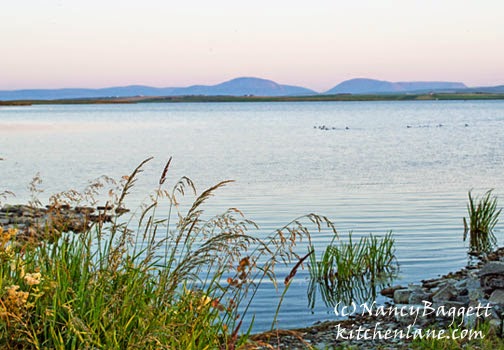

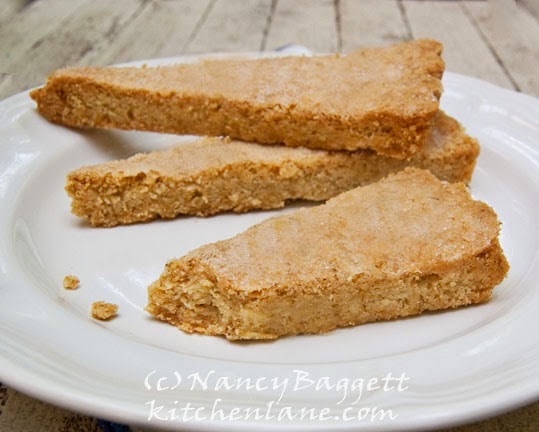
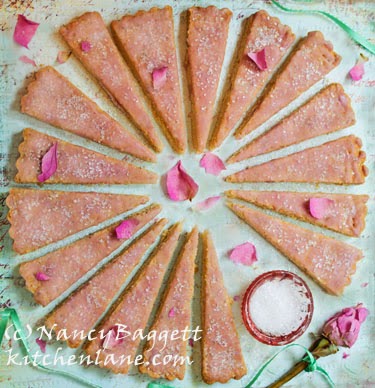


Thanks, Liz. I have many more pics that I just haven't had time to process yet. I am delighted to hear that you like my pics better than some in a guidebook!
Your wonderful post makes me to excited to anticipate our trip to the Orkneys next summer. Terrific shots, better than my guidebooks!
Nancy-
I can see why you and Charlie wanted to visit the Orkneys. So beautiful. An so unfamiliar to most of us. Talk about "off the beaten path…" Thanks so much for sharing.
Binnie Syril Braunstein
Thanks Chassie. Everywhere I looked I found gorgeous shots just waiting to be taken. In fact I took more than 5,000 pics!
Fantastic shots, Nancy. Looks like a fascinating place to visit. Thanks for sharing!!
Great pix. Looks like a fab vacation.
I'm amazed that your husband visited there–up until recently not that many people did. Now that the word has gotten out about the amazing archeology, more peeps are going. And they won't be disappointed!
I followed your photos on Facebook of this marvelous vacation and have to admit I was jealous! Scotland, the Orkney Islands are gorgeous and just what I imagined! Husband visited a long long time ago and it is one place he would love to go back… and bring me! But we haven't yet so I went vicariously through you! Thanks for sharing and thanks for the recipe and reminding me how delicious a teatime snack shortbread is!